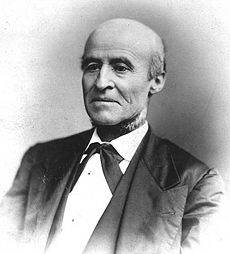
José Manuel Gallegos
Encyclopedia

United States Congress
The United States Congress is the bicameral legislature of the federal government of the United States, consisting of the Senate and the House of Representatives. The Congress meets in the United States Capitol in Washington, D.C....
from the Territory of New Mexico.
Born in Abiquiú
Abiquiú, New Mexico
Abiquiú, or Abiquiu is a small unincorporated town located in Rio Arriba County, in northern New Mexico in the southwestern United States, about 53 miles north of Santa Fe. In the 1730s, it was the third largest settlement in the New Mexico Territory...
, in what is now Rio Arriba County, New Mexico
Rio Arriba County, New Mexico
-2010:Whereas according to the 2010 U.S. Census Bureau:*51.6% White*0.5% Black*16.0% Native American*0.4% Asian*0.0% Native Hawaiian or Pacific Islander*3.3% Two or more races*28.2% Other races*71.3% Hispanic or Latino -2000:...
, Gallegos attended parochial schools. He studied theology at the Jesuit run College of Durango
Durango, Durango
-Climate:The city of Durango has a semi-arid climate, classified as Bsk in the Koppen system. The climate is temperate in the western portion , with the average annual temperature being 15 °C and consisting of an average annual rainfall of 1,600 millimeters. In the eastern region, the average...
(Colegio de Durango), Republic of Mexico, graduated in 1840, and was ordained a Roman Catholic priest. He served as member of the legislative assembly of what was then the Department of New Mexico, Republic of Mexico from 1843 to 1846. He served as member of the first territorial council of the Territory of New Mexico in 1851.
Gallegos was elected as a Democrat
Democratic Party (United States)
The Democratic Party is one of two major contemporary political parties in the United States, along with the Republican Party. The party's socially liberal and progressive platform is largely considered center-left in the U.S. political spectrum. The party has the lengthiest record of continuous...
to the Thirty-third
33rd United States Congress
The Thirty-third United States Congress was a meeting of the legislative branch of the United States federal government, consisting of the United States Senate and the United States House of Representatives. It met in Washington, D.C. from March 4, 1853 to March 3, 1855, during the first two years...
US Congress (March 4, 1853 – March 3, 1855). He was elected to a second term but served only briefly, March 4, 1855, to July 23, 1856, as he was succeeded by Miguel Antonio Otero (I)
Miguel Antonio Otero (I)
Miguel Antonio Otero was a prominent Spanish politician of the New Mexico Territory and instrumental in the economic development of the territory.- Early life :...
, who had successfully contested Gallegos's election. He served as member of the territorial house of representatives 1860-1862 and served as speaker. He was an unsuccessful candidate for election in 1862 to the Thirty-eighth
38th United States Congress
-House of Representatives:Before this Congress, the 1860 United States Census and resulting reapportionment changed the size of the House to 241 members...
US Congress.
In 1862, Gallegos was made a prisoner of war by the Texas Confederate troops when they came through Santa Fe
Santa Fe, New Mexico
Santa Fe is the capital of the U.S. state of New Mexico. It is the fourth-largest city in the state and is the seat of . Santa Fe had a population of 67,947 in the 2010 census...
. He served as Treasurer of the New Mexico Territory in 1865 and 1866, and as Superintendent of Indian Affairs in New Mexico in 1868.
Gallegos was elected as a Democrat
Democratic Party (United States)
The Democratic Party is one of two major contemporary political parties in the United States, along with the Republican Party. The party's socially liberal and progressive platform is largely considered center-left in the U.S. political spectrum. The party has the lengthiest record of continuous...
to the Forty-second
42nd United States Congress
The Forty-second United States Congress was a meeting of the legislative branch of the United States federal government, consisting of the United States Senate and the United States House of Representatives. It met in Washington, D.C. from March 4, 1871 to March 3, 1873, during the third and fourth...
US Congress (March 4, 1871 – March 3, 1873). At the time he did not speak English and asked to be permitted a translator on the Floor of the House of Representatives, this request was denied. He was an unsuccessful candidate for reelection in 1872 to the Forty-third
43rd United States Congress
The Forty-third United States Congress was a meeting of the legislative branch of the United States federal government, consisting of the United States Senate and the United States House of Representatives. It met in Washington, D.C. from March 4, 1873 to March 4, 1875, during the fifth and sixth...
US Congress. He died in Santa Fe, and was interred there in the Catholic Cemetery.

